PriorityQueue
PriorityQueue通过二叉小顶堆实现,可以用一棵完全二叉树表示。
优先队列:优先队列的作用是能保证每次取出的元素都是队列中权值最小的(Java的优先队列每次取最小元素,C++的优先队列每次取最大元素)。元素大小的评判可以通过元素本身的自然顺序(natural ordering),也可以通过构造时传入的比较器(Comparator,类似于C++的仿函数)。
Java中PriorityQueue实现了Queue接口,不允许放入null元素;其通过堆实现,具体说是通过完全二叉树(complete binary tree)实现的小顶堆(任意一个非叶子节点的权值,都不大于其左右子节点的权值),也意味着可以通过数组来作为PriorityQueue的底层实现。
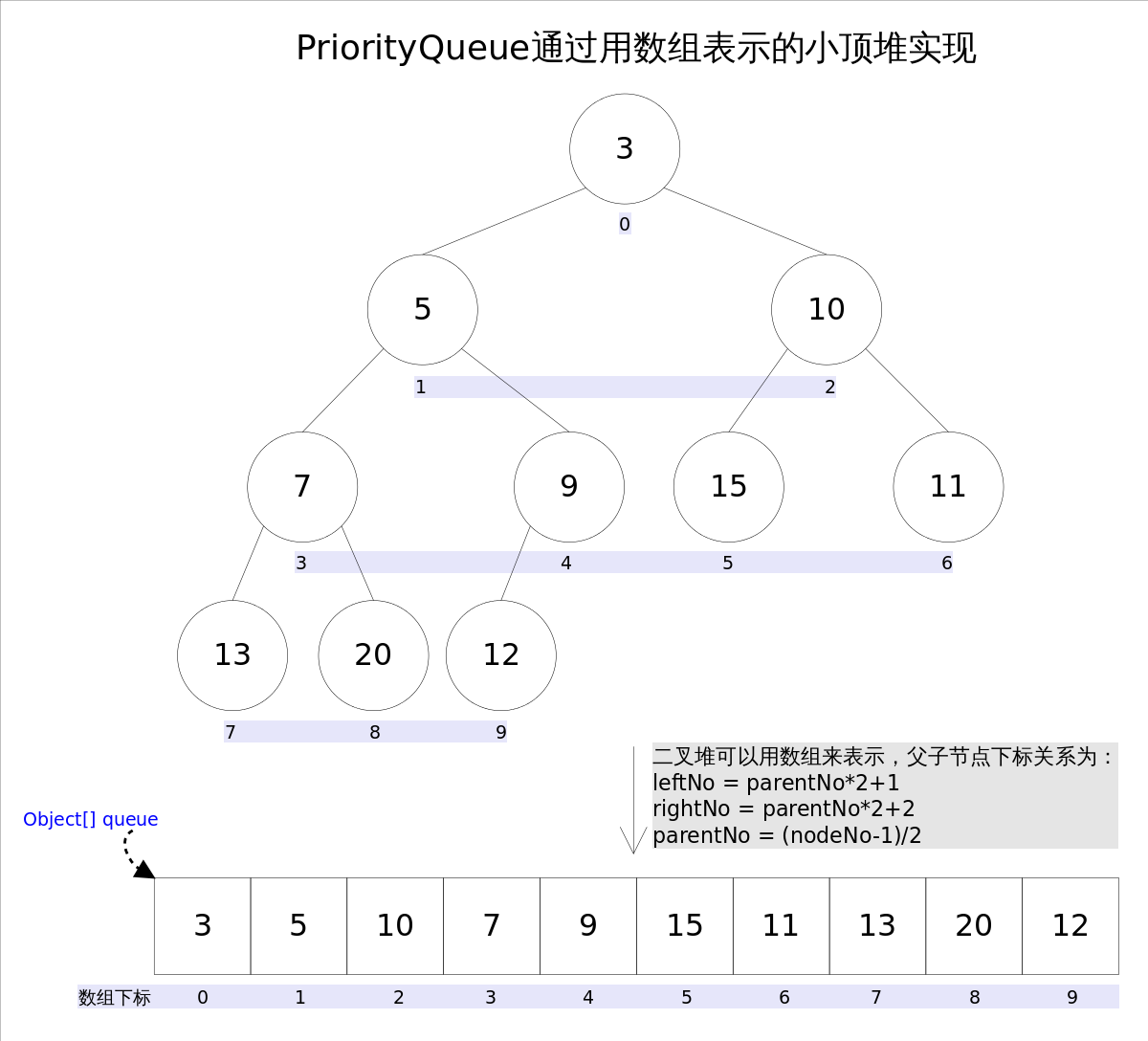
确切的说父子节点的编号之间有如下关系:
leftNo = parentNo*2+1 rightNo = parentNo*2+2 parentNo = (nodeNo-1)/2
PriorityQueue的peek()和element操作是常数时间,add(), offer(), 无参数的remove()以及poll()方法的时间复杂度都是log(N)。
add()和offer()
add(E e)和offer(E e)的语义相同,都是向优先队列中插入元素,只是Queue接口规定二者对插入失败时的处理不同,前者在插入失败时抛出异常,后则则会返回false。对于PriorityQueue这两个方法其实没什么差别。
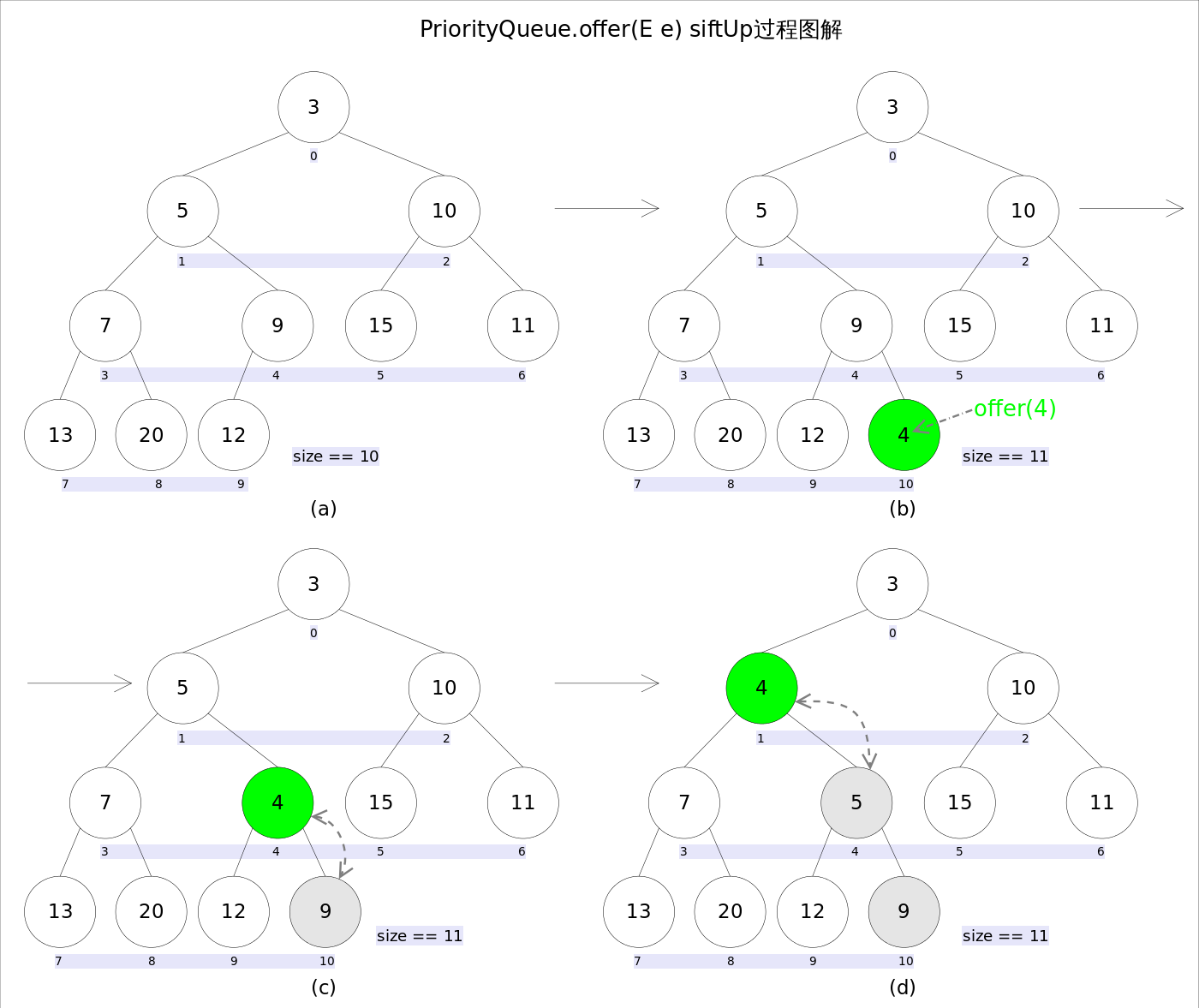
新添加的元素破坏小根堆结构,需要进行调整
/** * Inserts the specified element into this priority queue. * * @return {@code true} (as specified by {@link Queue#offer}) * @throws ClassCastException if the specified element cannot be * compared with elements currently in this priority queue * according to the priority queue's ordering * @throws NullPointerException if the specified element is null */ public boolean offer(E e) { if (e == null) throw new NullPointerException(); modCount++; int i = size; //在数组的末尾添加元素e if (i >= queue.length) grow(i + 1); //进行扩容 size = i + 1; if (i == 0) queue[0] = e; else siftUp(i, e); return true; }
需要注意的是siftUp(int k, E x)方法,该方法用于插入元素x并维持堆的特性。
/** * Inserts item x at position k, maintaining heap invariant by * promoting x up the tree until it is greater than or equal to * its parent, or is the root. * * To simplify and speed up coercions and comparisons. the * Comparable and Comparator versions are separated into different * methods that are otherwise identical. (Similarly for siftDown.) * * @param k the position to fill * @param x the item to insert */ private void siftUp(int k, E x) { if (comparator != null) siftUpUsingComparator(k, x); else siftUpComparable(k, x); } @SuppressWarnings("unchecked") private void siftUpComparable(int k, E x) { Comparable<? super E> key = (Comparable<? super E>) x; while (k > 0) { int parent = (k - 1) >>> 1; Object e = queue[parent]; if (key.compareTo((E) e) >= 0) break; queue[k] = e; k = parent; } queue[k] = key; } @SuppressWarnings("unchecked") private void siftUpUsingComparator(int k, E x) { while (k > 0) { int parent = (k - 1) >>> 1; Object e = queue[parent]; if (comparator.compare(x, (E) e) >= 0) break; queue[k] = e; k = parent; } queue[k] = x; }
新加入的元素x可能会破坏小顶堆的性质,因此需要进行调整。调整的过程为:从k指定的位置开始,将x逐层与当前点的parent进行比较并交换,直到满足x >= queue[parent]为止。注意这里的比较可以是元素的自然顺序,也可以是依靠比较器的顺序。
element()和peek()
element()和peek()的语义完全相同,都是获取但不删除队首元素,也就是队列中权值最小的那个元素,二者唯一的区别是当方法失败时前者抛出异常,后者返回null。
根据小顶堆的性质,堆顶那个元素就是全局最小的那个;由于堆用数组表示,根据下标关系,0下标处的那个元素既是堆顶元素。所以直接返回数组0下标处的那个元素即可。
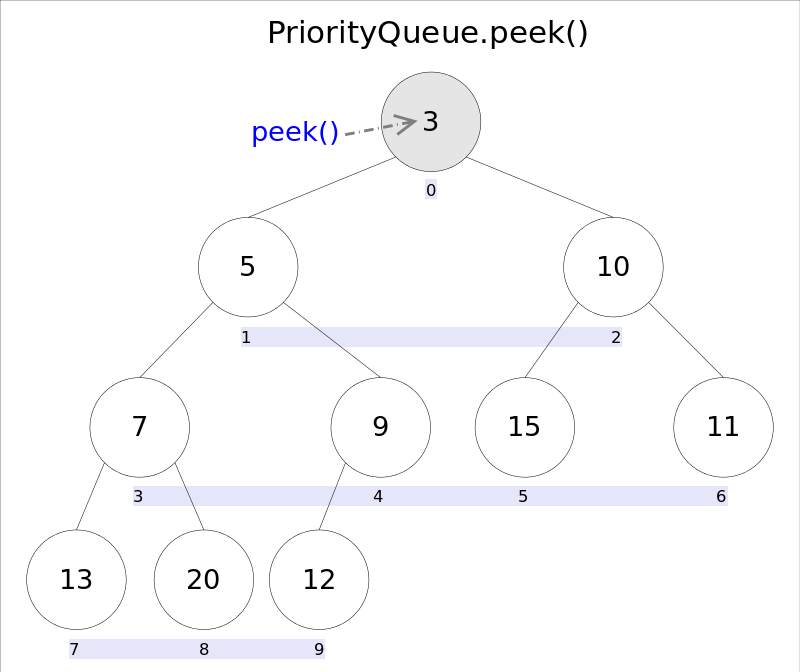
@SuppressWarnings("unchecked") public E peek() { return (size == 0) ? null : (E) queue[0]; }
remove()和poll()
remove()和poll()方法语义完全相同,是获取并删除队首元素,区别是当方法失败时前者抛出异常,后者返回null。由于删除操作会改变队列的结构,为维护小顶堆的性质,需要进行必要的调整。
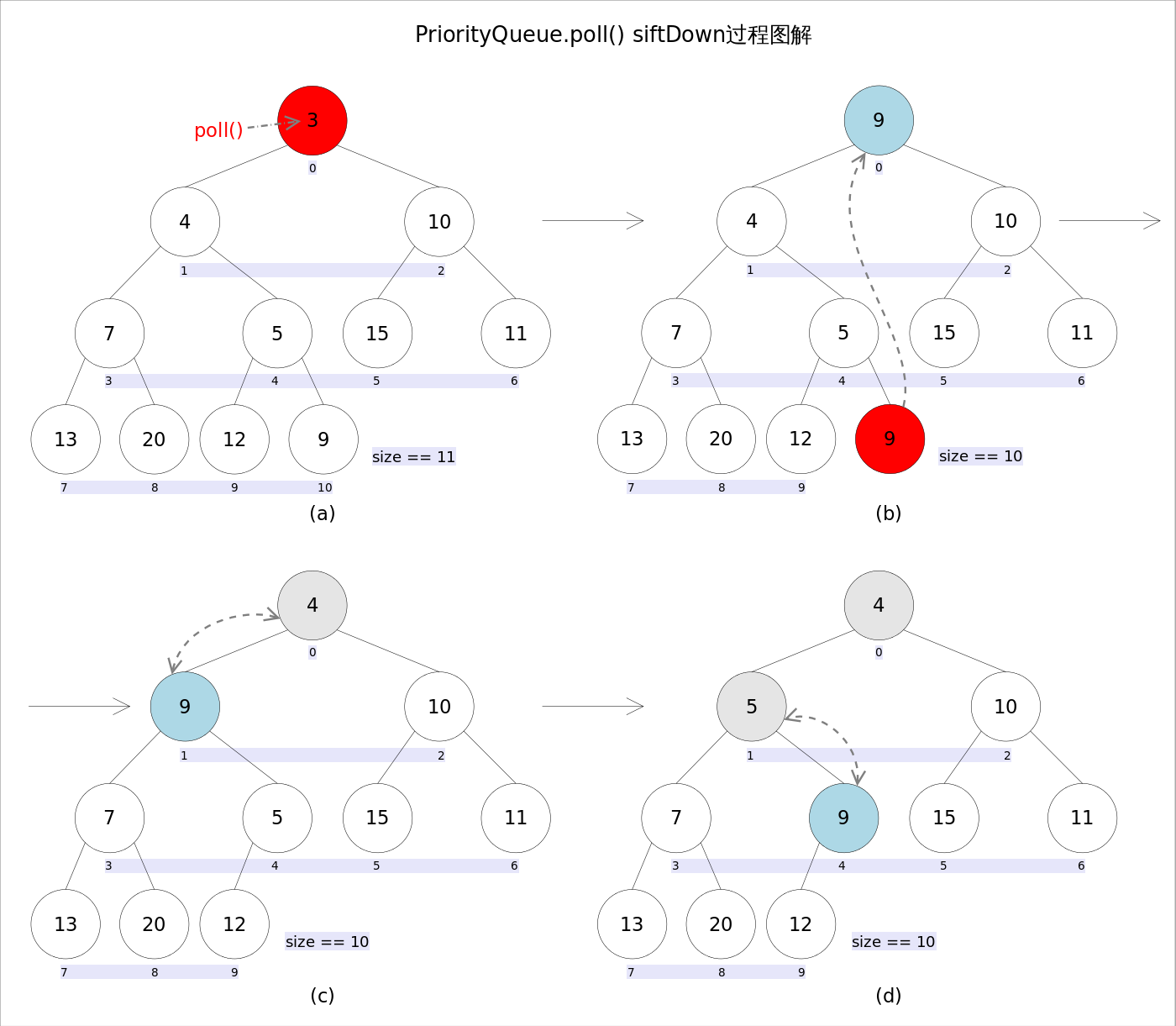
@SuppressWarnings("unchecked") public E poll() { if (size == 0) return null; int s = --size; modCount++; E result = (E) queue[0]; //返回头节点 E x = (E) queue[s]; //最后一个节点替换 queue[s] = null; if (s != 0) siftDown(0, x); return result; } /** * Inserts item x at position k, maintaining heap invariant by * demoting x down the tree repeatedly until it is less than or * equal to its children or is a leaf. * * @param k the position to fill * @param x the item to insert */ private void siftDown(int k, E x) { if (comparator != null) siftDownUsingComparator(k, x); else siftDownComparable(k, x); } @SuppressWarnings("unchecked") private void siftDownComparable(int k, E x) { Comparable<? super E> key = (Comparable<? super E>)x; int half = size >>> 1; // loop while a non-leaf while (k < half) { int child = (k << 1) + 1; // assume left child is least Object c = queue[child]; int right = child + 1; if (right < size && ((Comparable<? super E>) c).compareTo((E) queue[right]) > 0) c = queue[child = right]; //从左右孩子节点中选择较小的节点 if (key.compareTo((E) c) <= 0) break; queue[k] = c; //最小的孩子节点上 k = child; } queue[k] = key; } @SuppressWarnings("unchecked") private void siftDownUsingComparator(int k, E x) { int half = size >>> 1; while (k < half) { int child = (k << 1) + 1; Object c = queue[child]; int right = child + 1; if (right < size && comparator.compare((E) c, (E) queue[right]) > 0) c = queue[child = right]; if (comparator.compare(x, (E) c) <= 0) break; queue[k] = c; k = child; } queue[k] = x; }
首先记录0下标处的元素,并用最后一个元素替换0下标位置的元素,之后调用siftDown()方法对堆进行调整,最后返回原来0下标处的那个元素(也就是最小的那个元素)。重点是siftDown(int k, E x)方法,该方法的作用是从k指定的位置开始,将x逐层向下与当前点的左右孩子中较小的那个交换,直到x小于或等于左右孩子中的任何一个为止。
remove(Object o)
remove(Object o)方法用于删除队列中跟o相等的某一个元素(如果有多个相等,只删除一个),该方法不是Queue接口内的方法,而是Collection接口的方法。由于删除操作会改变队列结构,所以要进行调整;又由于删除元素的位置可能是任意的,所以调整过程比其它函数稍加繁琐。具体来说,remove(Object o)可以分为2种情况:1. 删除的是最后一个元素。直接删除即可,不需要调整。2. 删除的不是最后一个元素,从删除点开始以最后一个元素为参照调用一次siftDown()即可。此处不再赘述。
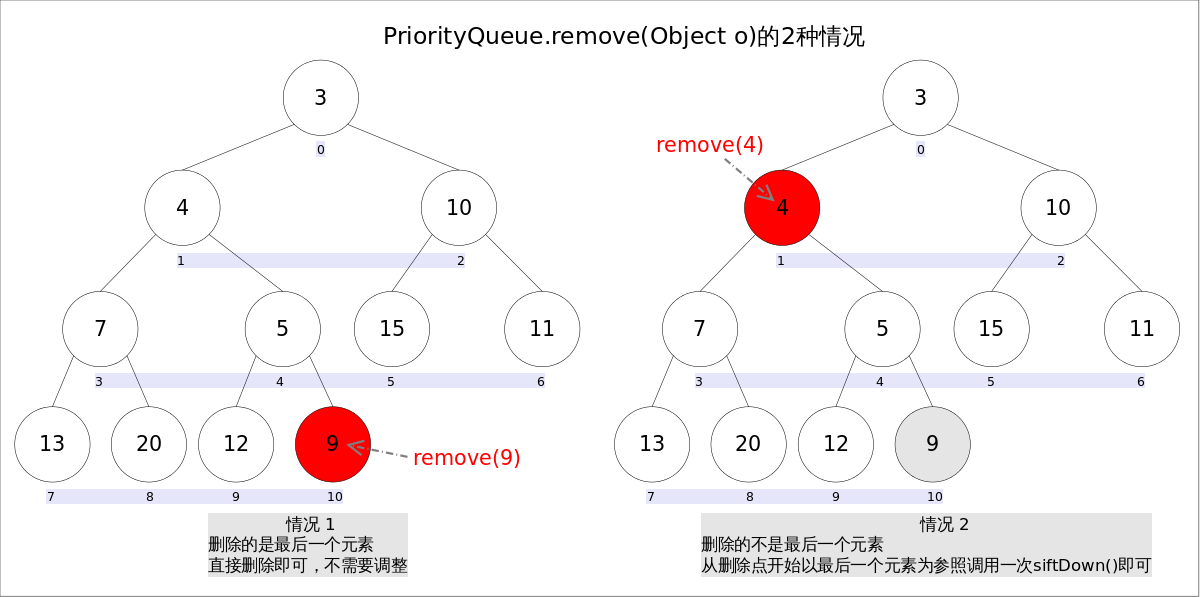
代码
/** * Removes a single instance of the specified element from this queue, * if it is present. More formally, removes an element {@code e} such * that {@code o.equals(e)}, if this queue contains one or more such * elements. Returns {@code true} if and only if this queue contained * the specified element (or equivalently, if this queue changed as a * result of the call). * * @param o element to be removed from this queue, if present * @return {@code true} if this queue changed as a result of the call */ public boolean remove(Object o) { int i = indexOf(o); if (i == -1) return false; else { removeAt(i); return true; } } /** * Removes the ith element from queue. * * Normally this method leaves the elements at up to i-1, * inclusive, untouched. Under these circumstances, it returns * null. Occasionally, in order to maintain the heap invariant, * it must swap a later element of the list with one earlier than * i. Under these circumstances, this method returns the element * that was previously at the end of the list and is now at some * position before i. This fact is used by iterator.remove so as to * avoid missing traversing elements. */ @SuppressWarnings("unchecked") private E removeAt(int i) { // assert i >= 0 && i < size; modCount++; int s = --size; if (s == i) // removed last element queue[i] = null; else { E moved = (E) queue[s]; queue[s] = null; siftDown(i, moved); if (queue[i] == moved) { //例如删除节点15 siftUp(i, moved); if (queue[i] != moved) return moved; } } return null; }
参考:
http://www.cnblogs.com/CarpenterLee/p/5488070.html






 浙公网安备 33010602011771号
浙公网安备 33010602011771号